Working in loosely connected spheres of inquiry, Holly Cahill is known to frequent a wide range of disciplines simultaneously. Be it architecture, choreography, fiber arts, painting, sculpture or hyperdimensional phenomena, one finds a distinct interconnectedness in her approach to formal ideas and materials. This week the COMP Magazine visited Cahill at her East Garfield Park studio to discuss the impact her family has had on her artistic investigations, her admiration for the work of previous practitioners like Louise Bourgeois and Eve Hesse, the interactive quality her work applies to the viewing experience, and her various curatorial projects.
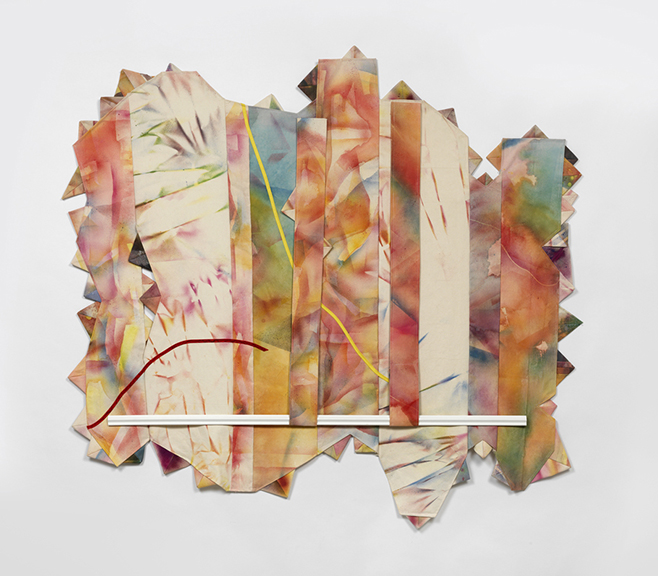
unprimed canvas and molding, 2017
You grew up in a small town in Kentucky, studied at Syracuse University and the University of Cincinnati. I’m fascinated with how you discussed your family. In conversation, you noted how your grandmother, working as a stenographer, saved money for years so that her grandkids could all go to college. She sounds like a remarkable woman, someone truly special. I’m curious if there are any other specific early experiences or people you see that set you on your present day path?
My grandmother was a remarkable women. Having grown up during the Great Depression, she wasn’t afforded a lot of breaks. I feel truly fortunate to have benefited so much from her resilience and generous spirit.
My father’s interest in the weather and architecture had a deep impact on me as a child. Growing up, we often listened to in-depth weather reports that went into fascinating detail describing the precipitation, sustained wind speeds, visibility conditions, temperature, and humidity, which all peaked my interest in the fluctuation of weather patterns throughout the planet. I also loved drawing maps when I was younger. All the craggy coast lines as compared to the straight border lines were interesting for me to depict in an exacting way. I was even accused of tracing a map of the U.S. once for a grade school assignment.
I was, of course, deeply wounded by this accusation!
I grew up on a street that had a lot of newer construction. The construction sites were like playgrounds where I would balance along the foundation walls like an acrobat performing on a tightrope. When I visited these sites with my father, he would point out where the different rooms in the house would eventually go. He was often able to locate the blueprint the construction workers were using, but sometimes we just had fun guessing the configurations of each room. We would observe the various stages of construction like when the plumbing, roof, or siding was introduced to the framework, but I loved the framing the most especially since you could see through an entire floor at once. There were no walls to block our views of the surrounding landscape. The experience of seeing a building quite literally come together before my eyes was transformational. That process took place very slowly and over many years in different locations throughout our neighborhood.
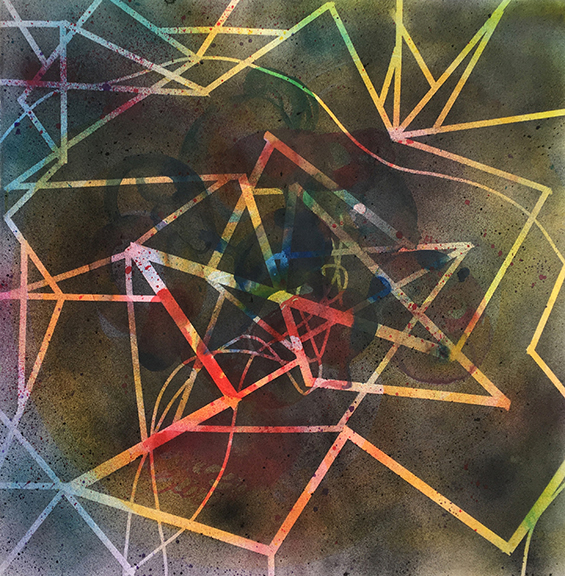
Your investigations traverse a wide array of items: architecture, choreography, landscape, and even, hyper-dimensional phenomena. How do you tie these seemingly disparate items? Where do you see this mode of inquiry being most successful?
Disparate was a word one of my favorite graduate school professors used a lot in relation to my work. It wasn’t likely meant in the most positive sense, but I think it fits actually and the nice surprise is that you think you’re working on all these different things, but then find they are interconnected. I’m a bit restless and I love discovering a new process of working so I explore a lot. Over time, these processes begin linking and feeding into one another. It’s really the exploration of process and materials that I value almost above anything else, but the work is really grounded in observation of the natural, unbuilt environment.
Rather than creating a depiction of natural forms, as I did in my early work, I now persuade my materials to behave as if they are the elements they reference. For example, I crush and harden fabric to reference rock, mountain ranges, and the impact of the human hand. Fluidity and mist are captured through spray and drips. Edges of forms are irregular in these earlier underpaintings where I often find my perspective is not unlike that of a cartographer recording the details of a place far above the landscape. These atmospheres and landscapes however embrace a less natural sense of color as they are deeply saturated and bright and meant to be energetic and inviting. Beginning from these underpaintings I introduce frameworks either through the linear elements of my works on paper or by joining together multiple works as is the case in my sewn, collaged paintings.
The frameworks foreground hidden elements such as the supportive beams in a building we understand are there but cannot be seen once the walls are completed. In contrast to darkness, these illuminated frameworks also take on other references outside of architecture such as an armature essential to clay sculpture, a diagram which can connect relationships among various elements, or an illuminated script that shows the pathway of the hand through the painting. In the sewn paintings, the architecture of the home is a place of focus, but through embracing different forms of making and traditions, such as quilt making, that many are now seeing as powerful works of art after years of marginalization.
I am also intrigued by what I see as a space outside of the built and unbuilt environments in these works that alludes to a strange, in-between zone. This zone is a place that is less defined and alludes to mysteries we have yet to discover whether they be from the everyday or cosmic. This interest has lead me to read science fiction and learn about the study of multiple dimensions, like the 4th dimension the surrealists were so fascinated with, and dark matter phenomena. Now, my research is taking me more within the human body and consciousness.
The series Propositional Object for a Future Interior, was the first I made with the intention to invite others to participate with my work through movement. Activity has been an interest within my work for a long time through the process of making. Through movement I find methods for creating. I am also a student of yoga and love experiencing how the various poses and sequences work with the body to release blocked energy. I have since learned other forms of movement, such as modern dance and enjoy breaking down the components of the sequences. I have a truly healthy respect for how much memory and practice is involved in them.
It’s hard to say which body of work is more or less successful, but I enjoy having many at once so that the viewer and I can enter into them from multiple vantage points.
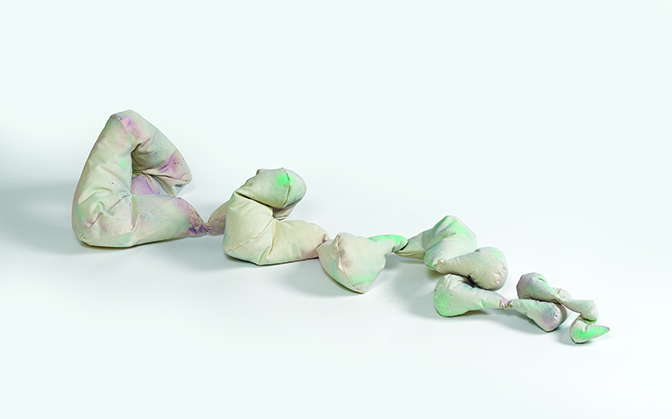
ink on canvas thread and fiberfill, 2014
You note the importance of process and exploration of materials to your practice. Can you walk us through your process when beginning a work or series? On what level does your conceptual and working practice function organically?
When I’m developing new work, I give myself time to try and fail at things. Most of the time this means that I make a few steps that will result in something I can’t control entirely and I try not to fret over what I make because I know it will go through some transformation before it arrives in a finished work. So much of life is planned and controlled. My studio work is the opposite of that at most junctures and especially when I’m developing new work. In my recent collages on paper, I have been using fragments left over from my painting process and then combining and cutting them.
Working methods that operate in a larger network of processes have a cyclical nature that allows me to produce many components at once. I’m drawn to materials that are a byproduct of the process and therefore weren’t intended for a specific purpose to remove some of the predictability. Similarly, I work with multiple large scale paintings on unprimed, unstretched canvas only to tear them apart and combine them with others. There is no road map to where I’m going, so, I stay in the moment and allow things to evolve.
Over the summer, I worked on returning to a love of mine from graduate school, printmaking, as an artist-in-residence at Spudnik Press Cooperative. My intention was to pick apart the layers and disrupt the sequencing that had been taking place in my work. I explored adding additional layers as well as others outside my usual practice which took shape in a series of 16 prints that are part of a limited edition called Shuffle. Shuffle brought lightness into my work in a new way and was still able to provide the level of chance I strive for. I printed 4 works at a time from one plate, repositioning and building them up with multiple runs through the press using intaglio plates, ghost printing, embossing, monotype, and a variety of other printmaking techniques. In the end, the prints form a network with one another, but still have their own identities.
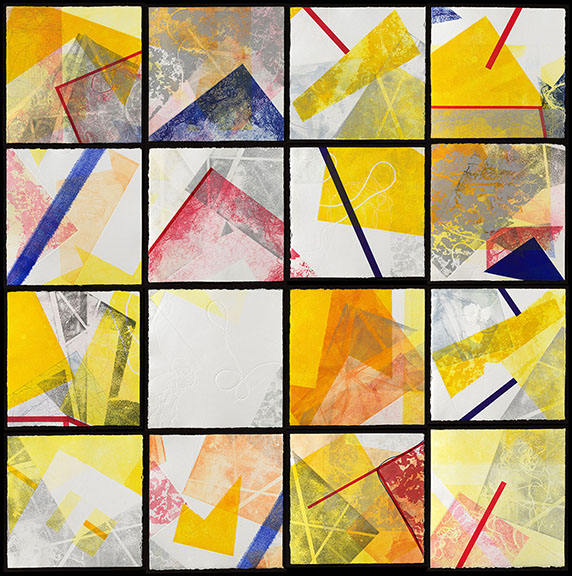
A number of your paintings (e.g., Tenderfoot, Propositional Object for a Future Interior E) are sculptural and malleable. Upon initial examination, there is a surface grotesqueness that draws the viewer in similar to that seen in the works of Louise Bourgeois and Eve Hesse. What draws you to creating soft-sculptural works versus working in a more static format? How do you conceive and execute these works?
I love that you mention both Bourgeois and Hesse. I’m a huge fan of their works and ways of translating the world. It’s often those things that are closest to who we are that are the scariest. I find the confrontation valuable.
I’m always curious what someone may do with an open ended nudge to participate. The sculptural paintings had been around for many years in different wall and floor works, yet I hadn’t explored activating them until 2014. I thought of the first roving sculptural painting works as a conversation of sorts which is why the series, Propositional Object for a Future Interior, are all titled with letters from the alphabet. I’m building on something that I think can take many forms and variations both within the series, but also in relationship to each person that interacts with them.
These works were conceived as multiples that can be scaled up or down, sometimes they are strung together, at other times they are separate. The interest in activation and softness with these particular works and the playful component are a way to disarm people and begin a conversation. I enjoy presenting a work that viewers can engage with, press their bodies against, or otherwise interpret how they think it should be manipulated.
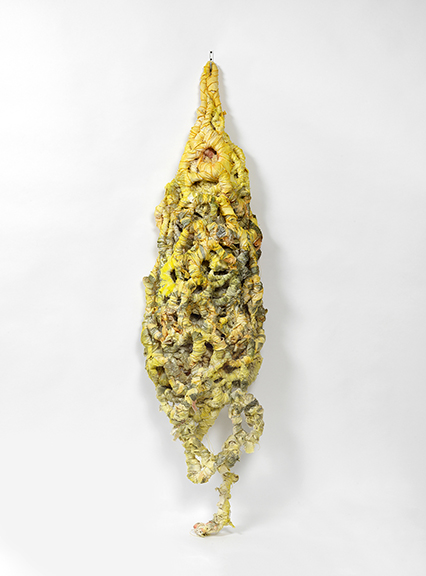
ink and dye on canvas, 2017
In addition to your studio practice, you’ve worked as a curator on a handful of projects. Recently, you curated a show for the Weinberg/Newton Gallery in River North. Can you share with us the intent of this project? Who are you working with? When did it open?
It’s hard to believe my curatorial practice just started a few years ago in 2017 with Sashay With and Without History, an exhibition I co-curated with Zachary Cahill as a member of Tiger Strikes Asteroid in Chicago. It was one of those experiences I had no idea I would enjoy as much as I did. From there, I curated a handful of other exhibitions including an exhibition booth at Satellite Art Show in Miami called Body Switchers, then in 2018 an exhibition titled Waterworld (also co-curated with Zachary Cahill), which took place at Columbia College’s Glass Curtain Gallery.
I’m grateful for the opportunity to have guest curated the current exhibition at Weinberg/Newton Gallery, Rebuilding the Present, which opened on January 18th. Weinberg/Newton Gallery has a compelling mission to give greater visibility to issues of social justice through partnering exhibitions with non-profit organizations. So many artists are devoted to those same issues non-profit organizations are working with, yet the gallery gracefully bridges the gap between them in a truly generous and generative way.
Rebuilding the Present is presented in partnership with the David Lynch Foundation and includes the work of Leslie Baum, Meredith Haggerty, Cameron Harvey, Susan Hiller, David Lynch, Stan Shellabarger and Rhonda Wheatley. I’m honored to work with all these amazing artists and with a partner organization that is committed to combating the effects of trauma and toxic stress on at-risk communities. Through teaching Transcendental Meditation to school children, veterans suffering with PTSD, families coping with the loss of loved ones, among others, they are working to improve health, cognition, and performance in life.
The title of the exhibition is meant to point towards ways of strengthening connection in the present moment when we are most directly in touch with our experiences. The artist’s works in the exhibition model ways of thinking through how we can reflect on and repair our frayed relationships in an often divisive, high stress, fast-paced contemporary world. Each artist addresses the theme of connection in a unique way whether through works that respond to our movements or those that ask us to reflect on how we can amplify intentions and let go of false notions of self that prevent growth. Other works consider our relationship to the digital and natural worlds and create space for meditation and stillness.
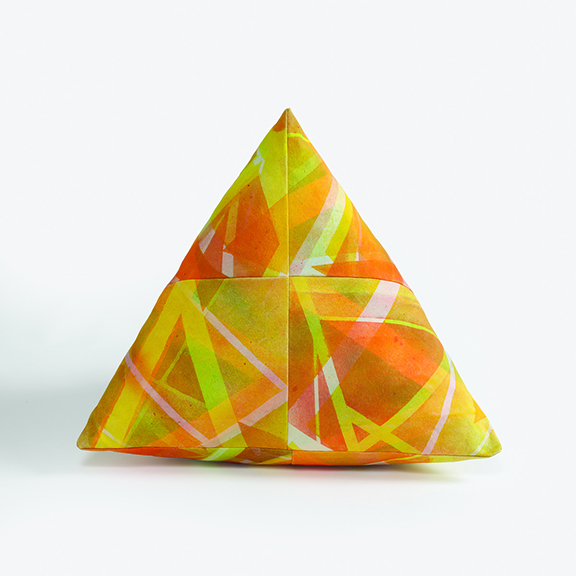
watercolor and ink on canvas thread and fiberfill, 2014
With much of your focus upon the exhibition at Weinberg/Newton Gallery, what else are you currently working on? Do you have any other projects or works underway? What’s the plan for 2019?
After a busy time of curating exhibitions, I’m excited to be focusing more on my own studio practice and creating a new body of work as a 2018-2019 Hatch Projects artist-in-residence at the Chicago Artist Coalition (CAC). My work will be included in two exhibitions at the CAC this year. One will be a two-person exhibition with my fellow Hatch artist-in-residence, Kushala Vora, working with our smaller group’s curator-in-residence, Alexis Brocchi. The other exhibition will include all the artists-in-residence and our three curators-in-residence working together. It is great to be part of the Hatch Projects community of artists and to have the support of our curators to tackle the themes within the exhibitions and pull together the connections among the artists. I’m also excited to continue learning from all the critiques and workshops that the CAC has to offer.
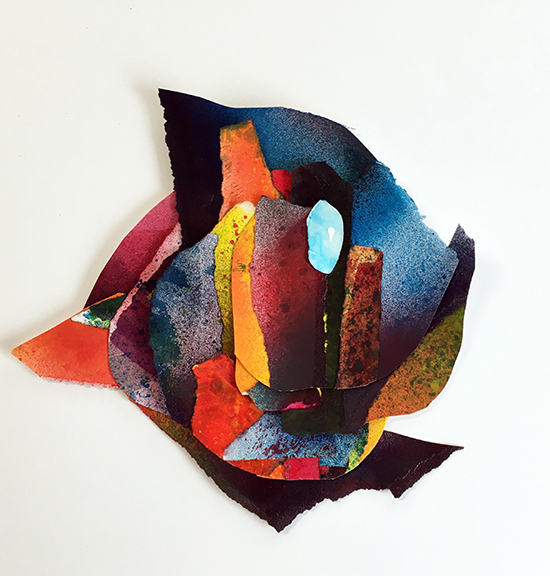
In preparation for these exhibitions, I’m currently working on a few new bodies of work. One consists of collaged paintings which will incorporate fibers techniques such as dry felting and hooking that are new to my practice. I’m also developing a series of new works on paper that draw inspiration from devices for imaging what is beneath the surface of the body, among other references. As with all my work, it would be impossible to say exactly what the end result may be, but I’m looking forward to the process.
For additional information on the aesthetic and curatorial practice of Holly Cahill, please visit:
Holly Cahill – www.hollycahill.com
Spudnik Press – https://www.spudnikpress.org
Chicago Artists Coalition – http://www.chicagoartistscoalition.org/programs/hatch-projects/2018-2019
Tiger Strikes Asteroid – http://www.tigerstrikesasteroid.com
Weinberg/Newton Gallery – http://weinbergnewtongallery.com
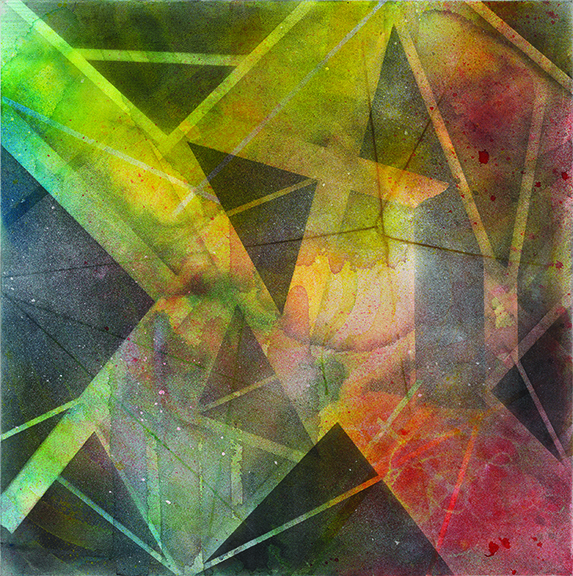
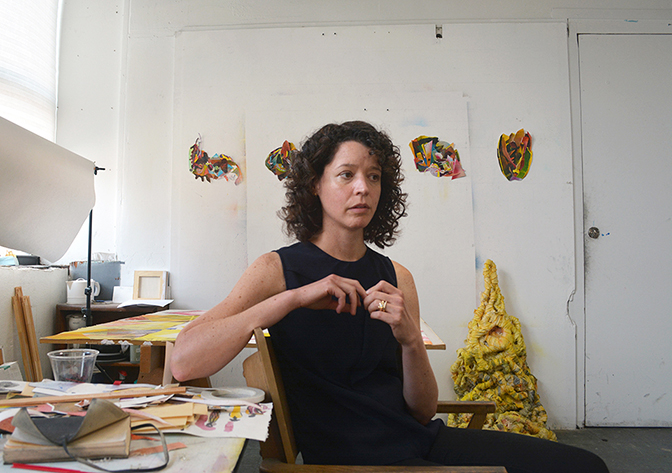
Artist interview and portrait by Chester Alamo-Costello


